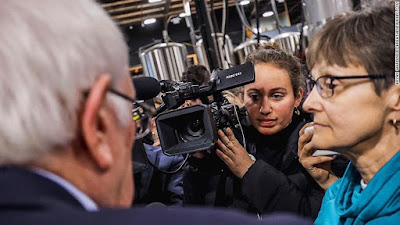Writing for the Ear and Eye: Audio and Video
 |
| Annie Grayer of CNN shown in a CNN photo gallery of reporters covering the 2020 election campaign. |
Read for Oct. 28, 2024: Your two chapters this week describe two kind of audio and video script writing: an audio news release (ANR) and a video news release (VNR).
That’s OK, as far as it goes, but the world of PR scripting for audio and video is broader than those two artifacts. Next week, we’ll cover advertising, and a script for a “public service announcement,” (PSA) a kind of ad open only to nonprofits or government agencies, will bring this genre of writing back. And the week after that, we cover speech writing, which is another format in which, like VNR and ANR and other video and audio scripts, you’re writing for the ear. In other words, your audience won't see or read your words, they will hear them.
Think of the many ways audio and video are used in communication:
- Radio and TV. While the media world has diversified, these can still be key ways to reach key publics.
- Online video. Mount Mercy attempts to use video in various formats, including messages to the community from key officials. I don’t know if you’ve looked at them, but there is a whole set of videos about MMU and COVID-19 in a “safe return to campus” YouTube playlist. Online videos are often on YouTube channels, but there are other venues where video is shared, too, such as Vimeo or directly loading video to an organization’s web site.
 |
| MMU nursing professor in university online video |
- Online audio. This can be a visual experience, such as a narrated slide show, that sort of bridges the gap between audio writing and video writing. Podcasts, often audio-on-demand episodes that explore a topic, have been a hot trend in media in recent years. In recent years, Dr. Nate Kline, former dean of students who left MMU in summer 2023, showed PR use of such audio with a series of MMU podcasts.
- Advertising. Both online and in traditional broadcast outlets, audio and particularly video content is common. Think of the ads that pop up on YouTube videos as a minor example.
- Social media. Facebook “stories” or livestreams are popular venues for spreading messages. Audio and video files can be linked via Twitter. I got the link for Dr. Klein's podcast on Spotify, for example, from a Facebook post. Blogs frequently use audio or video—often, for instance, embedding a window to a YouTube video in a blog post. And, of course, for about 15 years, vlogs, or video blogs, have been part of the YouTube experience. Recently, TikTok has become a hot site, partly due to its ease of use and brief video format.
With the exception of a site like TikTok that caters to the common user, most of this audio and video media content depends on a larger effort than the listener or watcher may be aware of. Even if a person creates vlog posts on their own, they are typically scripting them, shooting them and editing them. Anne Reburn, a singer-songwriter who does many 1960s and 1970s era song covers, noted in one post that a 3-minute song video represents about two days of labor, if she’s working alone.
Not all audio or video is as stylized, choreographed or heavily edited as most music videos are. But my point is still valid: Just as a magazine or newspaper involves a more complex editing process than most readers may image, so does the creation of audio and video content.
For instance, here is one in a series of YouTube videos posted by Mount Mercy to introduce it's new president, Dr. Todd Olson, in 2021. As you look at this video, think of the work that went into it: Scripting, choice of music, shooting with more than one camera, B roll of other people, the choice of setting, etc. Nothing about the video is haphazard or left to chance--and it all rests, at its foundation on writing:
So, if you’re a communication student and you aspire to work in the media field and prefer video or audio—sharpen your script writing tools. Media in all forms depends on writing, and there are lots of jobs for people who process material for public display, whether that processing involves web pages, brochures, news releases or videos.
Video and audio content is often made available by organizations online—so besides sending out a produced ANR or VNR, some sites will post links to the raw materials that media organizations can use to create their own packages. See, for example, the CDC’s digital material on COVID-19.
I’ll leave you to read the style text for it’s valid description of the ANR and VNR artifacts we are covering this week. But I do want to cover guidelines you should remember for audio and video writing:
- Write for the ear. That means that your sentences should be short and simple in structure. A person consuming your content in either audio or video form has to “follow” easily. A reader is, by definition of the medium you’re using, more engaged in your content and thinking more deeply about your words. A listener or viewer may be engaged, but they are not as cognitively active. A reader can slow down, reread, think and proceed at their own pace. A listener lets the sound wash over them, and if the content gets away from them, they are mentally gone. Write for the ear. Make your script easy to hear.
- Write for the eye. This applies, of course, mostly to video writing. But as you write, you must plan and note what your audience is seeing as well as hearing. We’ll cover a particular format for video scripts that includes a two-column table design to describe both audio and video components. A version of that is shown in your style guide, but I will be directing you to do some things a bit differently than what the sample shows.
- Write what is to be read in a production script in ALL CAPS. To me, as a print writer, that’s an odd convention—legibility studies show that ALL CAPS is not as easy to read as normal capitalization—but the media world did not name me king yet, and I don’t get to set the rules. This, like most writing rules, is not universal, but it is common nonetheless. In other words, if words on the page are not recorded before the production process of an audio or video package, but instead are to be read by “talent” during the production and editing process, those words are ALL CAPITALIZED. As if your phone was shouting at someone in a DM. Partly, I think, this is due to the low resolution nature of teleprompters--text has to be big to be read well in that format. Also, the lower legibility may force a reader to slow down and be more careful.
- DOUBLE-SPACE IT, TOO. If it is to be read out loud, don’t single space it. If it’s reference to a sound bite or actuality (hint, know those terms from your text for a quiz), the convention is that the recorded words are typed normally and are also single-spaced. So if you see “normal” words on any audio or video script, that means those words are not meant to be read out loud by a narrator or reporter during the production of the audio or video project. They are words that have already been recorded in video or audio format, or descriptions and directions, and you are simply using those recorded words or giving that context in your project script.
- Learn the lingo. For any genre of writing, a writer needs to understand the language of that genre to write well. Besides “sound bite” and “actuality,” which are terms for a recorded voice used in audio or video production, know terms like “B-Roll” and “A-Roll.” Know that “dub,” short for “duplicate,” refers to adding another sound to something—like “dubbing” a narrator’s voice over slides or B-Roll (or nat sound in audio--the term dub is more common in video but can be done in audio, too).
An audio script is fairly straightforward in appearance, except that much of it, because it is meant to be read aloud, is in ALL CAPS. A video script is usually a 2-column table, with one column describing video, the other including audio. The portion of audio that is scripted to be read during production is still in ALL CAPS and double spaced.
This is a sample documentary script form the New York Film Academy, just to show you what such a tabular video format looks like:
We will review in class how to create such a table, but I hope that you're used tables in Word by now, so it won't seem too new to you.
Finally, don’t let script writing intimidate you. It, like any new writing genre, takes some time to get used to—and one trick to checking any script is to simply read it out loud and listen to it as you read. In time, you can learn to write a script easily. And if you're asked to write a script for the first time, do your best, and, if you can, first sample other scripts from your organization.




Comments
Post a Comment